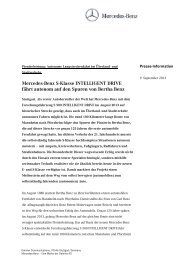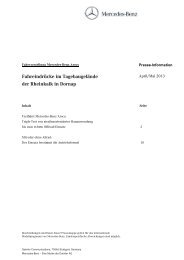S-Class – the pinnacle of automotive engineering
S-Class – the pinnacle of automotive engineering
S-Class – the pinnacle of automotive engineering
You also want an ePaper? Increase the reach of your titles
YUMPU automatically turns print PDFs into web optimized ePapers that Google loves.
Mercedes-Benz <strong>Class</strong>ic<br />
S-<strong>Class</strong> <strong>–</strong> <strong>the</strong> <strong>pinnacle</strong> <strong>of</strong> <strong>automotive</strong> <strong>engineering</strong><br />
A living legend that’s never gone out <strong>of</strong> fashion: ever since <strong>the</strong> beginnings <strong>of</strong> <strong>automotive</strong> history, <strong>the</strong> top models<br />
from Mercedes-Benz have been <strong>the</strong> most well-known and renowned embodiments <strong>of</strong> <strong>the</strong> fine art <strong>of</strong> <strong>automotive</strong><br />
<strong>engineering</strong>. With <strong>the</strong>ir trailblazing innovations <strong>the</strong>y have set new benchmarks for <strong>the</strong> development <strong>of</strong> passenger<br />
cars as a whole. This living tradition will be continued with <strong>the</strong> introduction <strong>of</strong> a new model series in <strong>the</strong> summer<br />
<strong>of</strong> 2013 which will carry <strong>the</strong> illustrious “S-<strong>Class</strong>” cachet into <strong>the</strong> future.
1903<br />
1928<br />
1930<br />
1937<br />
1951<br />
1951<br />
1954<br />
1959<br />
1963<br />
1965<br />
1972<br />
1979<br />
1991<br />
1998<br />
2005<br />
2013<br />
60 hp Mercedes-Simplex<br />
1903 <strong>–</strong> 1905<br />
Mercedes-Benz Nürburg<br />
W 08, 1928 <strong>–</strong> 1939<br />
Mercedes-Benz 770 “Grand<br />
Mercedes” W 07, 1930 <strong>–</strong> 1938<br />
Mercedes-Benz 320<br />
W 142, 1937 <strong>–</strong> 1942<br />
Mercedes-Benz 300<br />
W 186 and W 189, 1951 <strong>–</strong> 1962<br />
Mercedes-Benz 220<br />
W 187, 1951 <strong>–</strong> 1954<br />
Mercedes-Benz 220/220 S/220 SE<br />
W 180/W 128, 1954 <strong>–</strong> 1959<br />
Mercedes-Benz 220 <strong>–</strong> 300 SE long<br />
W 111/W 112, 1959 <strong>–</strong> 1965<br />
Mercedes-Benz 600<br />
W 100, 1963 <strong>–</strong> 1981<br />
Mercedes-Benz 250 S <strong>–</strong> 300 SEL 6.3<br />
W 108/W 109, 1965 <strong>–</strong> 1972<br />
Mercedes-Benz S-<strong>Class</strong><br />
116 series, 1972 <strong>–</strong> 1980<br />
Mercedes-Benz S-<strong>Class</strong><br />
126 series, 1979 <strong>–</strong> 1991<br />
Mercedes-Benz S-<strong>Class</strong><br />
140 series, 1991 <strong>–</strong> 1998<br />
Mercedes-Benz S-<strong>Class</strong><br />
220 series, 1998 <strong>–</strong> 2005<br />
Mercedes-Benz S-<strong>Class</strong><br />
221 series, 2005 <strong>–</strong> 2013<br />
Mercedes-Benz S-<strong>Class</strong><br />
222 series, from 2013<br />
The 60 hp Mercedes-Simplex is an<br />
early example <strong>of</strong> <strong>the</strong> unique luxury<br />
class tradition <strong>of</strong> Mercedes-Benz.<br />
The spacious, luxurious touring saloon<br />
dating back to 1904 once belonged<br />
to Emil Jellinek, <strong>the</strong> fa<strong>the</strong>r <strong>of</strong><br />
Mercedes Jellinek, after whom <strong>the</strong><br />
brand was named.<br />
The fact that <strong>the</strong> car was designed<br />
to be driven by a chauffeur is also<br />
reflected in <strong>the</strong> interior appointments:<br />
<strong>the</strong> passengers were seated<br />
in <strong>the</strong> rear on <strong>the</strong> finest brocade<br />
fabric, while <strong>the</strong> driver’s bench seat<br />
was covered in hard-wearing lea<strong>the</strong>r.<br />
The 60 hp Mercedes-Simplex followed<br />
<strong>the</strong> design <strong>of</strong> <strong>the</strong> 35 hp Mercedes,<br />
<strong>the</strong> development <strong>of</strong> which had been<br />
stimulated by Jellinek in 1900. To<br />
<strong>the</strong> present day, this first vehicle to<br />
bear <strong>the</strong> Mercedes name is regarded<br />
as <strong>the</strong> first modern car.<br />
The Nürburg 460 (W 08) made its<br />
debut in 1928 as <strong>the</strong> first series production<br />
Mercedes-Benz to feature<br />
an eight-cylinder engine. Its model<br />
designation “Nürburg” was derived<br />
from <strong>the</strong> Nürburgring circuit, which<br />
had been opened just a year earlier.<br />
The background to it being given<br />
this name comes from a spectacular<br />
endurance test in which a 460<br />
model covered some 20,000 kilometres<br />
over 13 days <strong>of</strong> driving at <strong>the</strong><br />
Nürburgring.<br />
Built at <strong>the</strong> Mannheim plant, <strong>the</strong><br />
luxury class model was continually<br />
enhanced from <strong>the</strong> outset. In <strong>the</strong><br />
autumn <strong>of</strong> 1929 it emerged with a<br />
lower frame and an even more elegantly<br />
designed body.<br />
The version produced in <strong>the</strong> form <strong>of</strong><br />
<strong>the</strong> elegant and luxurious Pullman<br />
saloon was one <strong>of</strong> <strong>the</strong> most popular<br />
variants <strong>of</strong> <strong>the</strong> eight-cylinder model<br />
which was available from 1934 to<br />
1939 with <strong>the</strong> model designation “500”.<br />
In 1930 Mercedes-Benz presented<br />
<strong>the</strong> 770 “Grand Mercedes” (W 07)<br />
model as <strong>the</strong> ultimate in <strong>automotive</strong><br />
<strong>engineering</strong>. The luxurious representative<br />
car for <strong>the</strong> most discerning<br />
<strong>of</strong> demands was fitted with a largedisplacement<br />
eight-cylinder supercharged<br />
engine which guaranteed<br />
an effortlessly superior performance.<br />
The new model, which continued<br />
<strong>the</strong> decades-old tradition <strong>of</strong> <strong>the</strong><br />
Mercedes-Benz luxury motor car, was<br />
individually manufactured at <strong>the</strong><br />
Mercedes-Benz Sindelfingen <strong>automotive</strong><br />
production facility, where<br />
specific customer requirements<br />
could be comprehensively accommodated.<br />
The “Grand Mercedes” proved just<br />
as popular with crowned and uncrowned<br />
heads <strong>of</strong> state as it did<br />
with representatives <strong>of</strong> industry and<br />
high finance.<br />
1937 witnessed <strong>the</strong> debut <strong>of</strong> a modern<br />
luxury touring car in <strong>the</strong> form<br />
<strong>of</strong> <strong>the</strong> Mercedes-Benz 320 (W 142).<br />
Its swing-axle chassis with independent<br />
wheel suspension provided for<br />
safe driving and a comfortable ride.<br />
From 1939, an additional remoteaction<br />
gear reduced engine speed<br />
and fuel consumption while enhancing<br />
travel comfort and efficiency.<br />
At <strong>the</strong> same time, a so-called exterior<br />
case was also added to <strong>the</strong><br />
standard scope <strong>of</strong> equipment for <strong>the</strong><br />
most spacious variant <strong>of</strong> this luxury<br />
model <strong>–</strong> <strong>the</strong> seven-seater Pullman<br />
saloon.<br />
This boot was permanently attached<br />
to <strong>the</strong> body’s rear panel, affording<br />
protection from wet and dirt for <strong>the</strong><br />
luggage, which was previously accommodated<br />
on an open luggage rack.<br />
Today <strong>the</strong> Mercedes-Benz 300<br />
(W 186) is primarily known by its<br />
nickname, <strong>the</strong> “Adenauer Mercedes”.<br />
Konrad Adenauer, <strong>the</strong> first Chancellor<br />
<strong>of</strong> <strong>the</strong> Federal Republic <strong>of</strong> Germany,<br />
was one <strong>of</strong> <strong>the</strong> first people<br />
to use <strong>the</strong> flagship Mercedes-Benz<br />
model in December 1951, and from<br />
that point on was only ever to be<br />
seen being chauffeured around in a<br />
“three hundred” model.<br />
At <strong>the</strong> time <strong>of</strong> its appearance at <strong>the</strong><br />
first IAA International Motor Show<br />
in Frankfurt in April 1951, six years<br />
after <strong>the</strong> end <strong>of</strong> <strong>the</strong> Second World<br />
War, <strong>the</strong> “three hundred” stood, like<br />
no o<strong>the</strong>r model, for Germany’s return<br />
to <strong>the</strong> international <strong>automotive</strong><br />
market.<br />
It not only served as a representative<br />
car for <strong>the</strong> world <strong>of</strong> politics and finance,<br />
it was also a comfortable and<br />
luxurious touring saloon.<br />
Alongside <strong>the</strong> spectacular 300 model,<br />
Mercedes-Benz presented a second<br />
luxury segment model at <strong>the</strong> first<br />
Frankfurt International Motor Show<br />
in 1951: <strong>the</strong> 220 model, which also<br />
featured a cutting-edge six-cylinder<br />
engine.<br />
While <strong>the</strong> more compact, less powerful<br />
220 model (W 187) may not have<br />
caused quite as much <strong>of</strong> a stir as<br />
its big bro<strong>the</strong>r, it never<strong>the</strong>less proved<br />
highly popular among customers.<br />
Its impressive performance moved<br />
<strong>the</strong> trade press to speak <strong>of</strong> its “sports<br />
car credentials”, while its handling<br />
characteristics were deemed to<br />
match comfort with safety in equal<br />
proportions. The lush interior also<br />
contributed to <strong>the</strong> popularity <strong>of</strong> this<br />
luxury segment model.<br />
Introduced in <strong>the</strong> spring <strong>of</strong> 1954,<br />
<strong>the</strong> type 220, also known internally<br />
as <strong>the</strong> 220 a (W 180), was <strong>the</strong> first<br />
Mercedes-Benz six-cylinder model<br />
with a unitised body design. Its ultra<br />
modern, spacious “ponton” body,<br />
which Mercedes-Benz had presented<br />
just six months earlier in <strong>the</strong> midrange<br />
180 model, <strong>of</strong>fered previously<br />
unheard <strong>of</strong> levels <strong>of</strong> comfort.<br />
Safe handling was guaranteed by <strong>the</strong><br />
single-joint swing axle, which was<br />
introduced into series production in<br />
<strong>the</strong> 220 model.<br />
With <strong>the</strong> launch <strong>of</strong> <strong>the</strong> overhauled<br />
and more powerful type 220 S in<br />
1956, <strong>the</strong> “S” designation became<br />
a permanent fixture in <strong>the</strong> names<br />
<strong>of</strong> high-end Mercedes-Benz models,<br />
underlining <strong>the</strong> special status <strong>of</strong> <strong>the</strong><br />
“ponton” six-cylinder.<br />
The 220, 220 S and 220 SE (W 111)<br />
“fintail models” launched in 1959<br />
earned <strong>the</strong>ir nickname from <strong>the</strong> subtle<br />
fintails at <strong>the</strong>ir rear wings. Yet<br />
<strong>the</strong>se style elements also had a purpose:<br />
<strong>the</strong>y served as a parking aid<br />
when reversing and as a result were<br />
<strong>of</strong>ficially called “sight lines”.<br />
Ano<strong>the</strong>r innovative feature proved<br />
more important than <strong>the</strong> fintails,<br />
however: <strong>the</strong> new luxury class generation<br />
from Mercedes-Benz was<br />
<strong>the</strong> world’s first passenger car to be<br />
fitted with a safety body. In <strong>the</strong> event<br />
<strong>of</strong> an accident, crumple zones at<br />
<strong>the</strong> front and rear absorbed <strong>the</strong> impact<br />
energy, <strong>the</strong>reby protecting <strong>the</strong><br />
occupants.<br />
In 1961 <strong>the</strong> 300 SE (W 112) fitted<br />
with standard air suspension and<br />
<strong>the</strong> newly developed Mercedes-<br />
Benz automatic transmission was<br />
launched.<br />
In 1963, <strong>the</strong> 600 model (W 100)<br />
presented at <strong>the</strong> IAA International<br />
Motor Show in Frankfurt became<br />
<strong>the</strong> new flagship model <strong>of</strong> <strong>the</strong><br />
Mercedes-Benz brand and at <strong>the</strong><br />
same stroke a vehicle <strong>of</strong> superlatives:<br />
its 6.3-litre V8 engine delivered<br />
an extremely respectable<br />
performance and a top speed in<br />
excess <strong>of</strong> 200 km/h.<br />
Optimum comfort was ensured by<br />
air suspension, an automatic transmission,<br />
electronic power steering<br />
and a unique hydraulic system.<br />
The five to six-seater version was predominantly<br />
ordered by highly discerning<br />
private customers. In addition,<br />
Mercedes-Benz also <strong>of</strong>fered a seven<br />
to eight-seater version with a wheelbase<br />
70 cm longer, which was primarily<br />
used as an <strong>of</strong>ficial state or<br />
ceremonial limousine.<br />
The W 108 and W 109 series saloons,<br />
which replaced <strong>the</strong> six-cylinder<br />
“fintail models” in 1965, were characterised<br />
by <strong>the</strong>ir timelessly elegant<br />
design and generously proportioned<br />
windows.<br />
In addition to models with conventional<br />
steel suspension <strong>–</strong> internally<br />
designated as <strong>the</strong> 108 series <strong>–</strong> as<br />
with <strong>the</strong> “fintails”, <strong>the</strong>re were also<br />
variants <strong>of</strong> <strong>the</strong> 109 series with air<br />
suspension which, from <strong>the</strong> start,<br />
were <strong>of</strong>fered with a wheelbase 10 cm<br />
longer.<br />
A particular highlight was <strong>the</strong> 300<br />
SEL 6.3 presented in 1968. The new<br />
top-<strong>of</strong>-<strong>the</strong>-range model in <strong>the</strong> series<br />
featured <strong>the</strong> powerful V8 engine from<br />
<strong>the</strong> high-end Mercedes-Benz 600<br />
saloon and provided proud owners<br />
not only with <strong>the</strong> ultimate in comfort<br />
and luxurious appointments but also<br />
sports car-like performance.<br />
In 1972 <strong>the</strong> luxury class saloons with<br />
which Mercedes-Benz had been setting<br />
standards for decades were <strong>of</strong>ficially<br />
given a name.<br />
The new 116-series S-<strong>Class</strong> featured<br />
a comprehensive safety concept<br />
including a fuel tank fitted over <strong>the</strong><br />
rear axle and protected against collisions,<br />
a four-spoke safety steering<br />
wheel, side windows designed to<br />
minimise <strong>the</strong> build-up <strong>of</strong> dirt, large<br />
headlamps, conspicuous indicators<br />
and ribbed tail lights also designed<br />
to minimise dirt build-up.<br />
In 1978, <strong>the</strong> S-<strong>Class</strong> became <strong>the</strong><br />
world’s first series production vehicle<br />
to become available with <strong>the</strong> ABS<br />
anti-lock braking system, designed<br />
to help retain steering control even<br />
under full brake application. At <strong>the</strong><br />
time a worldwide sensation, ABS is<br />
now standard across <strong>the</strong> <strong>automotive</strong><br />
industry.<br />
In 1979 <strong>the</strong> 126-series S-<strong>Class</strong> impressed<br />
with its aerodynamically<br />
enhanced shape and systematic<br />
weight reduction through <strong>the</strong> use <strong>of</strong><br />
elements such as <strong>the</strong> new light-alloy<br />
V8 engines.<br />
The model series 126 also set <strong>the</strong><br />
trend in terms <strong>of</strong> its design: it was<br />
<strong>the</strong> first Mercedes-Benz passenger<br />
car to do away with <strong>the</strong> traditional<br />
chrome bumpers in favour <strong>of</strong> deformable<br />
plastic ones built to withstand<br />
a “parking dent”.<br />
The airbag, now a key component<br />
<strong>of</strong> <strong>automotive</strong> safety, made its debut<br />
in 1981, in <strong>the</strong> model series 126,<br />
which had been launched two years<br />
earlier. The driver’s airbag was initially<br />
combined with a pyrotechnic<br />
belt tensioner for <strong>the</strong> front passenger.<br />
From 1988, Mercedes-Benz also<br />
<strong>of</strong>fered its customers a front passenger<br />
airbag.<br />
The S-<strong>Class</strong> <strong>of</strong> <strong>the</strong> model series 140<br />
represented <strong>the</strong> new superlative at<br />
Mercedes-Benz in 1991. In developing<br />
this model, <strong>the</strong> engineers and<br />
technicians focused on maximum<br />
comfort <strong>–</strong> not least due to <strong>the</strong> larger<br />
dimensions and double glazing for<br />
optimum acoustic insulation.<br />
This generation <strong>of</strong> <strong>the</strong> S-<strong>Class</strong> also<br />
introduced a pioneering safety innovation<br />
to <strong>the</strong> world <strong>of</strong> <strong>automotive</strong><br />
<strong>engineering</strong>: <strong>the</strong> ESP ® Electronic<br />
Stability Program, which was available<br />
from 1995 onwards.<br />
The innovative system reduces <strong>the</strong><br />
risk <strong>of</strong> skidding through targeted<br />
brake application on individual wheels.<br />
The end <strong>of</strong> 1996 saw <strong>the</strong> introduction<br />
<strong>of</strong> Brake Assist, which automatically<br />
builds up <strong>the</strong> maximum brake<br />
boosting effect during emergency<br />
braking.<br />
The new S-<strong>Class</strong> (model series 220)<br />
presented in 1998 <strong>of</strong>fered a fur<strong>the</strong>r<br />
increase in safety and comfort, not<br />
least due to <strong>the</strong> new electronically<br />
controlled AIRMATIC air suspension,<br />
COMAND control and display system,<br />
and innovative DISTRONIC proximitycontrolled<br />
cruise control system.<br />
In autumn 2002, <strong>the</strong> model series<br />
220 saw <strong>the</strong> introduction <strong>of</strong> <strong>the</strong> PRE-<br />
SAFE system designed to prepare<br />
occupants for any imminent collision<br />
by automatically initiating measures<br />
for <strong>the</strong>ir optimum protection.<br />
At <strong>the</strong> same time as <strong>the</strong> introduction<br />
<strong>of</strong> <strong>the</strong> new safety system, <strong>the</strong><br />
S-<strong>Class</strong> could now also be equipped<br />
with <strong>the</strong> intelligent 4MATIC permanent<br />
all-wheel drive, which also helps<br />
to ensure optimum traction in adverse<br />
road conditions at all times.<br />
The pioneering technical innovations<br />
<strong>of</strong> <strong>the</strong> S-<strong>Class</strong> model generation 221<br />
introduced in 2005 included Active<br />
Night View Assist, advanced DIS-<br />
TRONIC PLUS proximity control and<br />
Brake Assist Plus, which was upgraded<br />
to <strong>the</strong> PRE-SAFE brake with<br />
autonomous partial braking in 2006.<br />
Fur<strong>the</strong>r assistance systems, such as<br />
Blind Spot Assist, Lane Keeping<br />
Assist and Speed Limit Assist, helped<br />
to fur<strong>the</strong>r reduce <strong>the</strong> strain on <strong>the</strong><br />
driver and brought <strong>the</strong> S-<strong>Class</strong> one<br />
step closer to <strong>the</strong> vision <strong>of</strong> safe, accident-free<br />
driving.<br />
The Mercedes-Benz S 400 HYBRID<br />
launched in 2009 was <strong>the</strong> first luxury<br />
model with <strong>the</strong> efficiency-enhancing<br />
and environmentally friendly hybrid<br />
drive and also <strong>the</strong> first series production<br />
car with a lithium-ion battery.<br />
The best car in <strong>the</strong> world <strong>–</strong> each generation<br />
<strong>of</strong> <strong>the</strong> S-<strong>Class</strong> has earned itself<br />
this epi<strong>the</strong>t anew. Consequently,<br />
“perfection down to <strong>the</strong> last detail”<br />
was <strong>the</strong> tall order for <strong>the</strong> development<br />
<strong>of</strong> <strong>the</strong> forthcoming model series.<br />
The new luxury saloon will combine<br />
first-class mobility and responsibility<br />
to <strong>the</strong> highest standard from <strong>the</strong><br />
summer <strong>of</strong> 2013. The first-class rear<br />
compartment transforms <strong>the</strong> S-<strong>Class</strong><br />
into a comfortable <strong>of</strong>fice, while <strong>the</strong><br />
ENERGIZING massage function provides<br />
an ideal opportunity to indulge<br />
in a spot <strong>of</strong> wellness.<br />
Numerous innovative and optimised<br />
driving assistance systems to which<br />
Mercedes-Benz has given <strong>the</strong> generic<br />
name “Intelligent Drive” combine<br />
comfort with safety to open up a new<br />
dimension <strong>of</strong> motoring.





